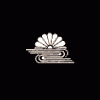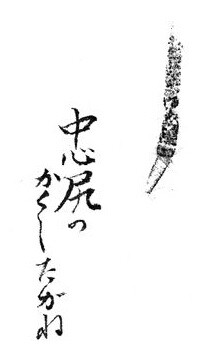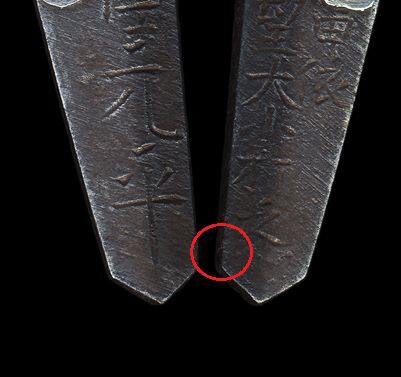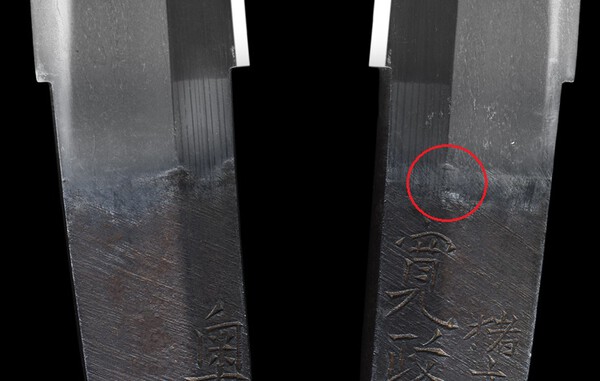-
Posts
925 -
Joined
-
Last visited
-
Days Won
23
Content Type
Profiles
Forums
Events
Store
Downloads
Gallery
Everything posted by Markus
-
I have dedicated the Kaga-Kiyomitsu line a chapter in my Nihon-shinto-shi. KagaKiyomitsuSchool.pdf
-

Confirmation help please: ENJU NAOHIRO aka DÔTANUKI MUNEHIRO
Markus replied to Cuirassier's topic in Translation Assistance
I backtracked the sources. The Toko-taikan says in the Dotanuki Munehiro entry that his family name was "Oyama" but does not mention any signature variants like "Naohiro". The Tosho-zenshu says in the Naohiro entry that his civilian name was "Oyama Hisataro (also read as Jutaro)" and that he also signed with "Munehiro", "Dotanuki", and "Naomitsu". Apart from that it is stated that Naohiro was a student of Naomune who in turn was a student of Suishinshi Masahide but that Munehiro was a direct student of Masahide. The pretty different signature style suggests that they were not the same person, i.e. the meiburi is too different to attribute this to different stages in a career. So maybe they were somehow related. I would love to have some more reference material here so that I might also be able to update the corresponding entries in my Index. -
I almost bought that tsuba some years ago! Enjoy it, its a nice one!
-
Sorry for hijacking this thread and my comment has nothing to do with the blade itself, but did the brush/pen slip here at the one oshigata? Come on Aoi Art, I know you can do better than this.
-
Nice! There is nothing more elegant than a well-proportioned tanto in suguha.
-
Peter, you are absolutely right with the ducks and their symbolism but the haiku is not connected to the motif. Bashô tried to encourage his readers to go out and "feel" and "experience" the snow rather than meeting for a stiff snow viewing gathering. Maybe it was the favourite poem of the commissioner of the piece or had some other context.
-
Thanks a lot Ludolf! Edited my post above.
-
Hi Peter, The poem is a haiku from Matsuo Bashô and reads: いざ行む雪見尓古ろぶ所まで Iza yukan, yukmi ni korobu, tokoro made. Well, let´s go snow-viewing till we slip and fall. The mei gives me a litte headache. I think it reads "Kishôtei Iehiro + kaô" (其升亭家弘) but "Kishôtei" was the gô of Ôtsuki Mitsuhiro (H 05188.0). So maybe I´m wrong with my reading "Iehiro" or there is also the possibility that we have here an unrecorded early name of Mitsuhiro... mei: "Seiryûken Yoshinori + kaô" 雙龍軒義則
-
I introduced a blade of the 1st and the 2nd generation in my book Shinto & Shinshinto-kantei Zenshu. Masanori1and2.pdf
-
Thank you Koichi san for your correction! I was wrongly looking for the characters (分合) whilst (會) is the old one for (会) of course. Problem was that what I found made a bit sense too, otherwise I might had been able to spot my mistake soon. Sorry for the confusion. @Adam: You can find a little info about me on my blog Unfortunately I don´t have the time at the moment as I am leaving in a couple of hours to our NBTHK-EB meeting.
-
The writing on the armband reads: Na, Shôwa-ku (名、昭和區) - Na(goya), Shôwa Ward Shôei-bungô (松榮分會) - Shôei municipal mergers and dissolution Seems that the man was an officer or staff responsible for one of the many municipal mergers and dissolutions carried out during the former half of the Shôwa era. Shôei was once a district of the Shôwa Ward.
-
Although not a teppô guy, I think the family name reads "Igawa" (井川) and not "Horikawa" and I think the reading for the characters (重尭) is "Shigetaka". Just to mention before Justin starts his investigation.
-
@Jamie: Can you provide us with a larger and sharper picture of the mei on the ura side?
-
Thank you Paul! I don´t want to rush in here just to advertize my books but the 30% off coupon of Lulu.com is now available up to Sunday 9th and there might be some "surprise offers" coming. Please see link below. http://www.lulu.com/home Sorry for my blunt advertising.
-
I would say yes, as I have seen several hozon-level papers for signed blades with supplements like kuni fumei (国不明, province unclear) but with at least vague datings like "late Muromachi period". So I interpret such papers as for unrecorded smiths (meikan-more, 銘鑑洩れ). Please take a look at the papers to these blades for example. http://www.e-sword.jp/sale/2011/1110_3012syousai.htm http://www.e-sword.jp/sale/2013/1310_3027syousai.htm But I´ve never seen and tokubetsu hozon paper of this kind. Would be interesting to be proven wrong. Also I would be eager to see an example of a paper which actually says "meikan-more".
-
It seems that there was no koto smith using these characters for "Moritoshi". Also I was unable to connect the family name "Hosokawa" to any of the Moritoshi found in the meikan records. So the smith is either meikan-more (not in the meikan lists), or there is always the possibility with ken that they bear the name of their donator if presented to a temple or shrine.
-
I read "Hosokawa Moritoshi" 細河盛俊 But only sure about the first three characters.
-
Update on the issue with the shinogi and the nakago-jiri: I was informed that at Motohira, the shinogi does not run directly into the tip of the kengyo-jiri as common for most smiths but runs out 2~3 mm at the side of that tip. It is not that obvious at the blade in question because the very end of the shinogi is not that crips, but I was told that at other Motohira blades, you can see that the shinogi does not end at the tip of the kengyo-jiri. Many thanks to the attentive reader!
-
@Chris: Its not found in the dictionaries and more one of those "unofficial" readings. But I have read it several times and for example the sword dealer Tonbo uses the characters with their reading "tonbo". http://kottou-tonbo.com/ As for the "katsumushi" reading, I used that one before but was told by a Japanese friend some years ago that I should avoid it and use "kachimushi" instead as it is the proper reading for the characters in question. However, he didn´t tell my if "katsumushi" is incorrect...
-
In the meanwhile I was contacted by someone who handled this very blade directly at Tsuruta in Japan. It seems that the person making the descriptions on the homepage mixed something up because the two tagane marks are exactly on the underside of the nakagojiri, i.e. only visible when holding the blade tip down. So we just have to forget about the "upper part of the nakago, one or two lines are engraved". I guess the person meant "upper face of the nakagojiri". That´s probably why this issue isn´t found at the Japanese site of Aoi Art. But regarding the shinogi issue, I am afraid I am not of much help in this respect as I haven´t heard of that peculiarity so far.
-
I think Peter refers to the other name of tonbo, kachimushi (勝虫), which means indeed literally "victory insect". By the way, the characters (勝虫) are often also just read "tonbo".
-
Tsuruta san provides a small oshigata of the nakago-jiri pointing out the kakushi-tagane. I guess on photo, it is the small notch we can see (circled in red). Regarding the two lines he mentions for the top part of the nakago, I must confess that I have no clue as I have never heard of them and they are also not address on the Japanese site of Aoi Art. My humble guess is what is circled in red in the pic below.







